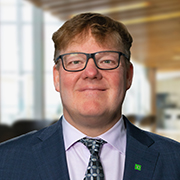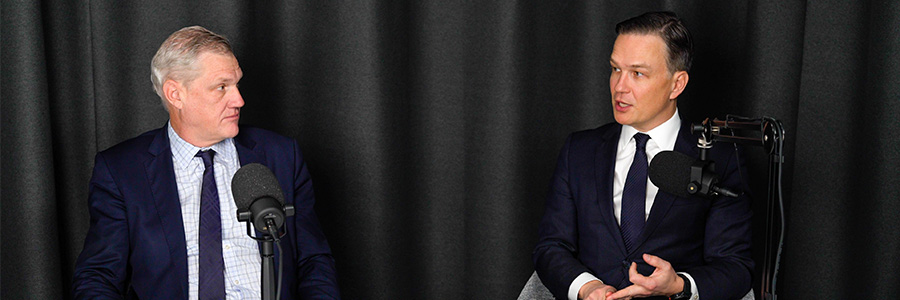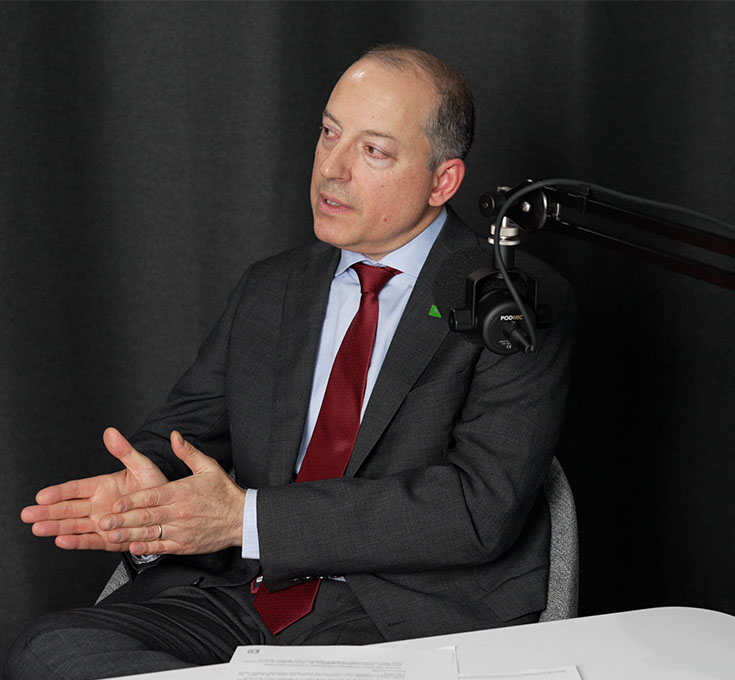Guest: Michael Faralla, Managing Director and Head of Global Mining, Investment Banking, TD Securities
Host: Peter Haynes, Managing Director and Head of Index and Market Structure Research, TD Securities
While commodity prices remain strong, the combination of high interest rates and relatively low investor interest in certain commodities may be limiting access to capital. Michael Faralla and Peter Haynes examine the unique ecosystem Canada has carved out in fostering capital formation, M&A activity across the industry, and geopolitical risks in countries processing the rare minerals used for energy transition. Listen in as they discuss the upcoming PDAC mineral exploration and mining convention, sharing their own memories and envisaging initial conversations that may ultimately become deals.
Listen to additional episodes for more perspectives from a variety of thought leaders on key themes influencing markets, industries and the global economy today.
This podcast was originally recorded on January 31, 2024.
MODERATOR: Welcome to Viewpoint, a TD Securities podcast. Listen in as we draw perspectives from a variety of thought leaders on key themes influencing markets, industries, and the global economy today. We hope you enjoy this episode.
PETER HAYNES: Welcome to episode 27 of Viewpoint, a TD Securities podcast where we explore trends in capital markets. My name is Peter Haynes, and I'll be your host for today's episode. And I'm pleased to be joined by Michael Farella, head of the global mining group at TD Securities. Michael, thanks for joining the show today.
MICHAEL FARELLA: Peter, thanks very much for having me,
PETER HAYNES: Well, Michael, we're taping this podcast just a short time before every bar and restaurant in the city of Toronto will be teeming with mining specialists and promoters congregating for the annual prospectors and developers conference, an event that's been running in Toronto, I think, for over 90 years. Tell me about the importance of this event to the mining sector, and is this the time that all the deals in your sector get done?
MICHAEL FARELLA: PDAC is the largest mining conference of its kind in the world. And we've got investors, governments, mining companies, prospectors, and promoters all congregating here. And it really is a unique opportunity to bring all those different parts of the mining ecosystem together. In fact, last year, there were more than 23,000 attendees.
PETER HAYNES: Do they have to stay at your house? I mean, I don't know if we have enough hotels in Toronto to do that.
MICHAEL FARELLA: I find they're staying out as far as the airport or even up in Markham. So yeah, no, the city is pretty much at capacity. It's pretty amazing. From our perspective, we see one of the main benefits of PDAC is bringing together all those people. It's an opportunity for us to connect with our clients, to connect with investors, and to share ideas and meet new companies and stories.
One of the great benefits of the PDAC conference is bringing those folks together. And it's where a lot of conversations start about either raising capital or potential merger or acquisition ideas. And so I think while deals don't necessarily get consummated at PDAC, we do find that a lot of transaction ideas get germinated here.
Initial discussions start and happen. They happen around those bars. They happen in meeting rooms. They happen on the side of presentations. And I think it's one of the great benefits of the conference and one of the reasons why it has been and continues to be so successful and attract so many people around the world.
PETER HAYNES: Well, I have a PDAC story. I started in 1989. I worked for the Stock Exchange. And I had a friend of mine whose father was a miner. And he told me about this conference that his dad went to every year, and he brought me along in 1990. I had just come out of school. I couldn't rub two nickels together, and it was the first time I'd ever experienced an open bar.
So that was my first memory of the PDAC conference back in 1990. And obviously, it's continued to grow over the years. I'm glad to hear it is an event that you guys will be enjoying. So the CEOs of companies are part of this event. And I'm just curious, as you're speaking to the CEOs, as you will be I'm sure in the next little while here, and we're into the first quarter of 2024, what are the top of mind issues in your conversations with CEOs right now?
MICHAEL FARELLA: Well, I think the mood is generally cautious but optimistic. And it very much varies by commodity. And the two main commodities which dominate our capital markets in North America being gold and copper, things have generally been quite constructive. Commodity prices have remained relatively strong. And so for producers, margins are good, and they're generally making good cash flow.
But one of the biggest challenges facing mining companies has been cost inflation, as you all know, driven by the general level of high inflation globally. And after working through a tough couple of years of rapidly rising costs, we're starting to see some moderation, which is providing some relief. For development stage companies who are trying to finance and build new projects, one of the biggest issues has been access to capital.
Equity markets were difficult for raising capital in 2023, and high interest rates meant that debt was more expensive and often harder to come by. So finding the capital to advance projects were tough. And I think those are two big challenges. And then probably, the third challenge is for those commodities that have been really weak is just really a lack of investor interest. And we've seen that with a big decline particularly in some of the battery metals like lithium and nickel.
PETER HAYNES: So as these conversations are happening at PDAC with CEOs, with bankers, et cetera, I turn my attention here to the M&A market. You are indicating it was a difficult climate to raise capital in 2023. I'm curious if you expect that raising capital in 2024 will be easier? Are you expecting members of the community that you cover to be in the market sourcing additional capital? And I'm curious about M&A. Are you expecting M&A to heat up in the sector in 2024?
MICHAEL FARELLA: So just addressing the raising capital question first. Again, I think we're reasonably optimistic. We're seeing better equity market tone generally across the board, and I think that is constructive for investor interest. I do think we do see the potential for an improving capital market environment for raising capital. We probably need to see sustained commodity prices, and we probably need to see also interest rates stabilizing and coming down first. But I'm optimistic that the environment is going to improve.
As it relates to M&A, I think M&A continues to be very topical across the industry. For many years, shareholders were demanding capital discipline and a focus on shareholder returns. But more recently, there's been a pivot back to growth as development pipelines and some of our larger clients have been depleted and investors seem to have had a more constructive attitude to replacing reserves and looking for growth.
And in the gold sector in particular, the market is quite fragmented, and with many mid-tier companies all competing for investor attention and capital. And that spurred a period of industry consolidation, which was actually led by the majors. So if you recall back in 2018, we saw Barrick merge with Randgold, which then led to Newmont buying Goldcorp, and then a series of mid-size and large mergers around the world culminating with the merger of Agnico Eagle and Kirkland Lake here in Canada, and Newmont, a US company, buying Newcrest, an Australian based gold company.
So M&A has been active in the gold sector for a while. And I believe it will continue as those smaller and mid-sized companies strive to achieve the benefits that scale has brought the majors. A more diversified asset base, a stronger balance sheet to be able to fund growth projects, and the potential for higher valuation multiples on increased growth prospects, diversification, and improved margins.
So in terms of gold companies looking to diversify into other commodities, it's a trend among the large caps which has been growing for a while. Particularly for the very large gold companies, it's increasingly difficult for them to find large tier one pure gold mines that move the needle for their already large asset base.
So increasingly, they're looking at large copper, gold projects or even in some cases pure copper projects to drive growth. These copper projects are typically longer life than gold projects and larger in terms of revenue and net asset value, which provides benefits in terms of improving their portfolio metrics-- improved margins, longer mine life, et cetera.
And it seems as though the investor base has embraced this as a sensible thing to do with Barrick, Newmont, and Agnico all adding material amounts of nongold production to their commodity mix.
PETER HAYNES: You mentioned gold and copper. I'm not a geologist. Why is it that when someone searching for gold, they often find copper? Why are they so closely aligned?
MICHAEL FARELLA: I'm not necessarily a geologist either, Peter, so I'm not sure I can give you the technical explanation. But what we have seen is these very large low grade copper porphyries, which tend to have gold mineralization associated with them. And so what makes those projects attractive is that you have this large copper project, which is long life, with the gold credit providing additional economics, which make them economically viable.
PETER HAYNES: So Michael, as we transition from a reliance on fossil fuels to one of energy efficiency, the world will start to wean itself off internal combustion engines. What are the countries that stand to benefit from this transition from the perspective of being home to the rare minerals needed for batteries? And where do the geographies of Canada and the US fit into this race to find the prize?
MICHAEL FARELLA: That's an interesting question, Peter, and one that's at the core of many of the government policies that have been implemented recently in response to that shift to the low carbon world that you talked about. One of the biggest challenges, I think, facing the EV sector and the battery metal supply chain is where those battery metals are mined and where they're processed.
Looking at three key battery metals, nickel, lithium, and cobalt, more than 2/3 of the world's cobalt comes from Africa, and specifically the Democratic Republic of the Congo. And more than half of the world's nickel is mined in Indonesia. While lithium is more widespread around the world, including coming from Chile, Argentina, and Australia, a significant portion of it is mined in Africa and China. And more than 75% of all lithium processing happens in China.
And for rare Earth metals, which are often used in magnets and motors, that number is more than 90% processed in China. So even if you're mining lithium in a friendly jurisdiction, it's most likely being sent to China for processing into the chemical grades that are used in an EV battery.
So to come back to your question, the opportunity for places like Canada and the US is that we do have significant resources of many battery metals, including nickel in Canada and both lithium and copper in the US and Canada. And as governments and end users, including the auto manufacturer OEMs and consumers, become more focused on security of supply and the carbon footprint in general ESG impact of the raw materials that are going into their products, there are increasing incentives to develop local supply chains for these raw materials.
In the past three to five years, we've seen most Western countries, including the EU, the United States, Australia, and Canada, implement some form of a critical mineral strategy, which has included dedicated funding for domestic supply of critical minerals, including those battery metals. In the United States, for example, the IRA included tens of billions of dollars of funding support for domestic supply through loans and subsidies, and Canada similarly provided almost $4 billion in its critical mineral strategy.
So the concepts of near-shoring, securing supply chains, and ensuring the ESG credentials, including the carbon footprint of the inputs into the EV batteries produced in North America, I think is likely to benefit development of projects in North America and Canada and the US. And so I think we're going to see more mines-- more nickel mines, more lithium mines being developed. And that should benefit our local industry.
PETER HAYNES: Well it's interesting the countries that you mentioned. First thing that comes to mind is geopolitical risk. And this is a key factor for the mining companies who are often operating in jurisdictions with unstable governments. And we can think about the recent experience of first quantum in Panama as a case in point.
For that matter, even in North America, and you mentioned Canada and the US, we have our own issues for mining companies. There's lots of complaints about permitting and how long it takes to get permits in Canada. And, of course, we have the risk that a Trump election in the fall of 2024 might result in higher taxes on foreign goods. As the walls around the world go up, what is the best approach for companies that are ensuring supply chains and access to critical mineral supplies?
MICHAEL FARELLA: I think as you rightly point out, geopolitical risks are increasing everywhere. And so I think companies are going to increasingly focus on operating in safer jurisdictions. I think we're always going to see Chinese and other foreign entities willing to operate in more challenging jurisdictions. But for Western companies, they will increasingly focus on or be aware of jurisdictional risk.
I think that means operating in places where the rule of law operates which have an established mining industry a mining code and a history of mining and an acceptance of mining in the country. And so when companies seek to develop a new project or enter a new region, I think there's going to be a heightened focus on government and community engagement and the explicit sharing of the benefits of the mining project development with both local communities as well as regional or federal governments.
I think communities want to see tangible benefits from mining projects, including job creation, infrastructure development, and profit sharing, as well as minimizing environmental impacts. I think that's what companies are going to be focused on. I think they're going to be minimizing jurisdictional risk, and also focusing on relationships with governments and communities to ensure the viability of their operations.
PETER HAYNES: Well, Michael, I know you're a big fan of Frank McKenna's geopolitics podcast. He just published his 10 predictions for 2024. And one of the questions he was asked are, what would be the geopolitical hotspot for 2024 if you were worrying in last year's answer was North Korea.
And this year, he said, I'm going to take a page out of what Eurasia said, and that is, the geopolitical hotspot for 2024 is the US. Which isn't an answer that you would expect to hear, but one that I think about and it concerns me a bit. So finally, Michael, today we both sit-in Toronto, Ontario, Canada, which is a place that quite arguably represents the center of the universe in the global mining sector.
We have all the infrastructure necessary to be a world class mining center with accountants, investment bankers like yourself, lawyers, analysts, mining sales specialists, regulators that understand the sector, and well-functioning stock exchanges that are all part of the ecosystem that helps Canada own this label. With the flow of capital redomiciling to the US, all of these trends that the US is the center of the financial markets universe, are you confident that Canada can maintain its leadership position in the mining sector?
MICHAEL FARELLA: Canada has developed, over many decades, this unique ecosystem of professionals all associated with the discovery, development, and financing of mining projects and companies. And I think one of our competitive advantages is that it's really hard to replicate that in any other capital market in a short period of time.
And also, because the mining sector is relatively speaking a much, much smaller part of the US capital markets, in my experience, they're often less accommodating or understanding of some of the unique requirements of the mining sector. Say, from a resource disclosure perspective or fostering early stage preproduction prerevenue mining companies as publicly listed entities.
And actually, I've seen several examples of companies wanting to pursue a dual listing or go directly to list on the NYSE or NASDAQ but have been unable to clear the SEC review due to issues with their project or their disclosure or they just didn't fit the general framework of the US regulatory environment.
In Canada, in contrast, we have specific rules and regulations to deal with all sorts of mining companies and projects at all different stages and have the lawyers, the bankers, the technical experts, and the regulators who have the regulatory framework and experience to deal with them and with unique issues.
While I don't disagree with you that the US will be an important source of capital and one which many mining companies do access via dual listing as they mature as public companies, I'm confident and hopeful that Canada will continue to be a place which fosters capital formation for the mining sector, and especially for early stage and small to mid-cap companies. I think our challenge will be to continue to retain them here as they grow and mature.
PETER HAYNES: Michael, I couldn't agree more with you. I do believe Canada has the chance to continue to own that mining space. I am, however, concerned that we do rest on our laurels from time to time. And I think we can even replicate the successes we've had in that sector in other areas. And let's hope that our regulators and our government and others understand how important this part of the ecosystem in capital markets is to the Canadian market.
And can you just imagine what the economic footprint of 23,000 people coming to Toronto for a conference here in a few weeks? It's just crazy. So Michael, I learned a lot here today. I follow the mining sector. Peripherally, I learned a lot from you, and I appreciate your time. Thanks for joining the show.
MICHAEL FARELLA: Thanks very much, Peter. Appreciate being here.
MODERATOR: Thank you for listening to Viewpoint, a TD Securities podcast. If you enjoyed this episode, subscribe to this series on Apple Podcasts or on your favorite podcast platform. For more thought leadership content, visit tdsecurities.com and follow us on LinkedIn for all the latest TD Securities updates. For relevant disclaimers to this podcast, please refer to the Viewpoint episode page on our website.
This podcast should not be copied, distributed, published or reproduced, in whole or in part. The information contained in this recording was obtained from publicly available sources, has not been independently verified by TD Securities, may not be current, and TD Securities has no obligation to provide any updates or changes. All price references and market forecasts are as of the date of recording. The views and opinions expressed in this podcast are not necessarily those of TD Securities and may differ from the views and opinions of other departments or divisions of TD Securities and its affiliates. TD Securities is not providing any financial, economic, legal, accounting, or tax advice or recommendations in this podcast. The information contained in this podcast does not constitute investment advice or an offer to buy or sell securities or any other product and should not be relied upon to evaluate any potential transaction. Neither TD Securities nor any of its affiliates makes any representation or warranty, express or implied, as to the accuracy or completeness of the statements or any information contained in this podcast and any liability therefore (including in respect of direct, indirect or consequential loss or damage) is expressly disclaimed.

Michael Faralla
Managing Director and Head of Global Mining, Investment Banking, TD Securities

Michael Faralla
Managing Director and Head of Global Mining, Investment Banking, TD Securities

Michael Faralla
Managing Director and Head of Global Mining, Investment Banking, TD Securities
Michael has over 25 years of experience in the investment banking business. He started his career as a metallurgist in the gold division of Anglo American Corporation (now AngloGold Ashanti) and later worked as a consultant with McKinsey & Co., consulting to the resources sector globally. Michael has advised on marquee transactions for Agnico Eagle, Barrick, BHP Billiton, Cameco, Cobalt 27, Equinox, Hudbay, IAMGold, Kinross and Turquoise Hill. Prior to assuming his current role, Michael led equity capital markets origination in the mining and oil and gas sectors with TD Securities.

Peter Haynes
Managing Director and Head of Index and Market Structure Research, TD Securities

Peter Haynes
Managing Director and Head of Index and Market Structure Research, TD Securities

Peter Haynes
Managing Director and Head of Index and Market Structure Research, TD Securities
Peter joined TD Securities in June 1995 and currently leads our Index and Market Structure research team. He also manages some key institutional relationships across the trading floor and hosts two podcast series: one on market structure and one on geopolitics. He started his career at the Toronto Stock Exchange in its index and derivatives marketing department before moving to Credit Lyonnais in Montreal. Peter is a member of S&P’s U.S., Canadian and Global Index Advisory Panels, and spent four years on the Ontario Securities Commission’s Market Structure Advisory Committee.







